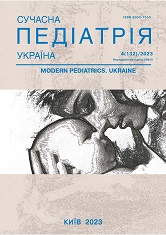A clinical case of manifestation of primary immunodeficiency diagnosed before as Burkitt’s lymphoma
DOI:
https://doi.org/10.15574/SP.2023.132.104Keywords:
lymphoma, primary immunodeficiency, clinical peculiarities, diagnosticsAbstract
Lymphoma is a group of neoplastic diseases characterized by the clonal proliferation of lymphoid cells, manifested by the response of various stages of differentiation of normal B-lymphocytes, less often T-lymphocytes or natural killer cells. The etiology of most lymphomas is unknown. Some of the proven causal-consequence factors are: viral infections and immunodeficiency conditions.
Purpose - to draw the attention of non-immunologists to the peculiarities of detecting the primary immunodeficiency (PID) states and the problem of their late diagnosis based on the data of a clinical case.
Clinical case. A clinical observation of severe non-genetically differentiated PID is given. Screening signs of PID in the form of recurrent infectious respiratory tract syndrome and frequent long-term use of antibacterial drugs are highlighted, which should alert doctors to clinical and immunological markers of primary immunodeficiency. The presence of Burkitt's lymphoma in the boy also does not exclude the possibility of the manifestation of an immunodeficiency state, both secondary to the drug treatment of lymphoma, and primary, which can manifest itself in puberty. Common variable immunodeficiency is one of those PIDs that "starts" with Burkitt's lymphoma.
Conclusions. The problem of low detection of probable PID in children in Ukraine is urgent. Primary care physicians are the first to be able to partially solve this problem by examining the infectious history and laboratory screening tests. There is incomplete awareness of related medical specialties regarding the signs of PID in lymphoproliferative syndrome in children. This clinical case demonstrates signs of PID at an early age. Low detection is also associated with poor capacity and quality and/or lack of immunological laboratory testing, particularly in public facilities.
The research was carried out in accordance with the principles of the Helsinki Declaration. The informed consent of the of the child’s parents was obtained for the research
No conflict of interests was declared by the authors.
References
Baré P, Parodi C, Malbrán A et al. (2017). Progressive reduction of circulating B lymphocytes in patients with X-linked lymphoproliferative disease (XLP). Br J Haematol. 177 (4): 648-650. https://doi.org/10.1111/bjh.14087; PMid:27220551
Chernyshova LI, Volokha AP, Kostiuchenko LV ta in. (2013). Dytiacha imunolohiia. Pidruchnyk. Medytsyna: 720.
Dułak N, Juwa J, Trzciński R, Majeranowski A, Irga-Jaworska N. (2022). Hematological manifestations of X-linked lymphoproliferative disease. Hematology in Clinical Practice. 13 (1): 1-6. https://doi.org/10.5603/HCP.a2022.0002
Frederik V, Rasmussen D. (2019). How to Identify Common Variable Immunodeficiency Patients Earlier: General Practice Patterns. Journal of Clinical Immunology. 39: 641-652. https://doi.org/10.1007/s10875-019-00666-9; PMid:31372799
Ishimura M, Eguchi K, Shiraishi A et al. (2019). Systemic Epstein-Barr Virus-Positive T/NK Lymphoproliferative Diseases with SH2D1A/XIAP Hypomorphic Gene Variants. Front Pediatr. 7: 183. https://doi.org/10.3389/fped.2019.00183; PMid:31231620 PMCid:PMC6558365
MSD Manual. (2023). Immunodeficiency Disorders. URL: https://www.msdmanuals.com/professional/immunology-allergic-disorders/immunodeficiency-disorders.
Nicholas L, Kutac С, Hajjar J et al. (2017). Health-Related Quality of Life in Adult Patients with Common Variable Immunodeficiency Disorders and Impact of Treatment. Journal of Clinical Immunology. 37: 461-475. https://doi.org/10.1007/s10875-017-0404-8; PMid:28536745 PMCid:PMC5489588
Odnoletkova I, Kindle G, Quinti I et al. (2018). The burden of common variable immunodeficiency disorders: a retrospective analysis of the European Society for Immunodeficiency (ESID) registry data. Orphanet Journal of Rare Diseases. 13: 201. https://doi.org/10.1186/s13023-018-0941-0; PMid:30419968 PMCid:PMC6233554
Panchal N, Booth C, Cannons JL et al. (2018). X-linked lymphoproliferative disease type 1: a clinical and molecular perspective. Front Immunol. 9: 666. https://doi.org/10.3389/fimmu.2018.00666; PMid:29670631 PMCid:PMC5893764
Popov MM, Piontkovska OV, Ovcharenko LS ta in. (2018). Pervynni imunodefitsyty u ditei. Osoblyvosti diahnostyky ta likuvannia. Navchalnyi posibnyk. Kharkiv: Vydavnychyi tsentr KhNU im. V.N. Karazina: 118.
Downloads
Published
Issue
Section
License
Copyright (c) 2023 Modern pediatrics. Ukraine

This work is licensed under a Creative Commons Attribution-NonCommercial 4.0 International License.
The policy of the Journal “MODERN PEDIATRICS. UKRAINE” is compatible with the vast majority of funders' of open access and self-archiving policies. The journal provides immediate open access route being convinced that everyone – not only scientists - can benefit from research results, and publishes articles exclusively under open access distribution, with a Creative Commons Attribution-Noncommercial 4.0 international license (СС BY-NC).
Authors transfer the copyright to the Journal “MODERN PEDIATRICS. UKRAINE” when the manuscript is accepted for publication. Authors declare that this manuscript has not been published nor is under simultaneous consideration for publication elsewhere. After publication, the articles become freely available on-line to the public.
Readers have the right to use, distribute, and reproduce articles in any medium, provided the articles and the journal are properly cited.
The use of published materials for commercial purposes is strongly prohibited.

